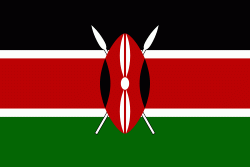Nakuru
Nakuru is a city in the Rift Valley region of Kenya. It is the capital of Nakuru County, and was formerly the capital of Rift Valley Province. As of 2019, Nakuru had an urban and rural population of 570,674 inhabitants, making it the largest urban center in the Rift Valley, with Eldoret in Uasin Gishu County following closely behind. The city lies along the Nairobi Nakuru Highway, a distance of 160 kilometers from Nairobi, the capital of Kenya. It is the third largest city and fourth largest urban center in Kenya, behind Nairobi, Mombasa and Ruiru respectively. It lies about 1,850 m above sea level.
Archaeological discoveries located about 8 km from the Central Business District at the Hyrax Hill reserve have been dated to the prehistoric period.
The city was created on January 28, 1904 when an area within a circle having a radius of one mile from the main entrance to the railway station was proclaimed to be a township. The name of the town was derived from the Maasai-speaking people of Kenya.
During the colonial era, the British established Nakuru as part of the White highlands during the colonial era, and Nakuru became a municipality in 1952.
Following the founding of the Republic of Kenya the first and second presidents of Kenya, Jomo Kenyatta and Daniel Arap Moi, had their semi-official residences within the city. The city for a long time has been a hotbed of Kenyan politics and has been a home to politicians such as the late Kariuki Chotara, Kihika Kimani, the late Mirugi Kariuki and Koigi Wamwere.
During the 2007 post-election violence dozens of buildings in Nakuru were burnt to the ground.
On 3 June 2021, Nakuru was officially endorsed for city status after the Kenyan Senate voted for its elevation from a municipality. Following the approval of the Senate of Kenya in June, the President of the Republic of Kenya gave a city charter for official transformation of Nakuru to a city status in December 1, 2021, making it the fourth urban center in Kenya to be declared a city after Nairobi, Mombasa and Kisumu.
Archaeological discoveries located about 8 km from the Central Business District at the Hyrax Hill reserve have been dated to the prehistoric period.
The city was created on January 28, 1904 when an area within a circle having a radius of one mile from the main entrance to the railway station was proclaimed to be a township. The name of the town was derived from the Maasai-speaking people of Kenya.
During the colonial era, the British established Nakuru as part of the White highlands during the colonial era, and Nakuru became a municipality in 1952.
Following the founding of the Republic of Kenya the first and second presidents of Kenya, Jomo Kenyatta and Daniel Arap Moi, had their semi-official residences within the city. The city for a long time has been a hotbed of Kenyan politics and has been a home to politicians such as the late Kariuki Chotara, Kihika Kimani, the late Mirugi Kariuki and Koigi Wamwere.
During the 2007 post-election violence dozens of buildings in Nakuru were burnt to the ground.
On 3 June 2021, Nakuru was officially endorsed for city status after the Kenyan Senate voted for its elevation from a municipality. Following the approval of the Senate of Kenya in June, the President of the Republic of Kenya gave a city charter for official transformation of Nakuru to a city status in December 1, 2021, making it the fourth urban center in Kenya to be declared a city after Nairobi, Mombasa and Kisumu.
Map - Nakuru
Map
Country - Kenya
 |
 |
| Flag of Kenya | |
Kenya's earliest inhabitants were hunter-gatherers, like the present-day Hadza people. According to archaeological dating of associated artifacts and skeletal material, Cushitic speakers first settled in Kenya's lowlands between 3,200 and 1,300 BC, a phase known as the Lowland Savanna Pastoral Neolithic. Nilotic-speaking pastoralists (ancestral to Kenya's Nilotic speakers) began migrating from present-day South Sudan into Kenya around 500 BC. Bantu people settled at the coast and the interior between 250 BC and 500 AD. European contact began in 1500 AD with the Portuguese Empire, and effective colonisation of Kenya began in the 19th century during the European exploration of the interior. Modern-day Kenya emerged from a protectorate established by the British Empire in 1895 and the subsequent Kenya Colony, which began in 1920. Numerous disputes between the UK and the colony led to the Mau Mau revolution, which began in 1952, and the declaration of independence in 1963. After independence, Kenya remained a member of the Commonwealth of Nations. The current constitution was adopted in 2010 and replaced the 1963 independence constitution.
Currency / Language
| ISO | Currency | Symbol | Significant figures |
|---|---|---|---|
| KES | Kenyan shilling | Sh | 2 |
| ISO | Language |
|---|---|
| EN | English language |
| SW | Swahili language |















